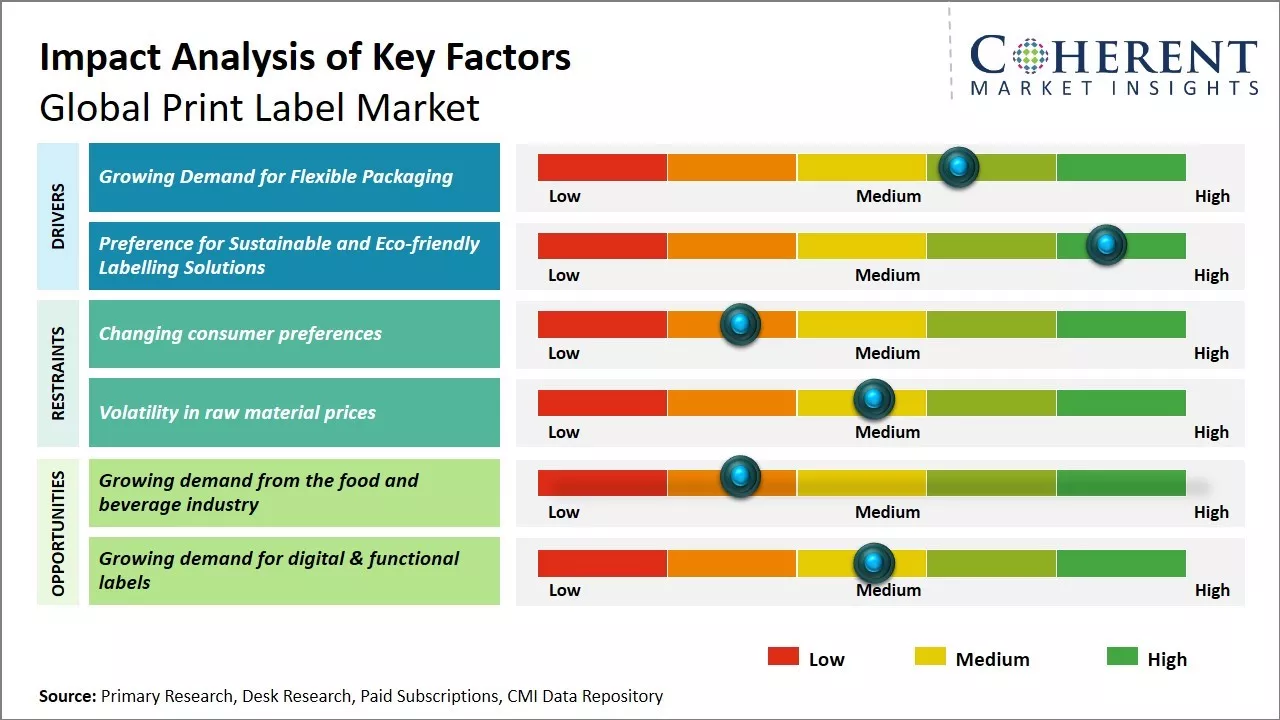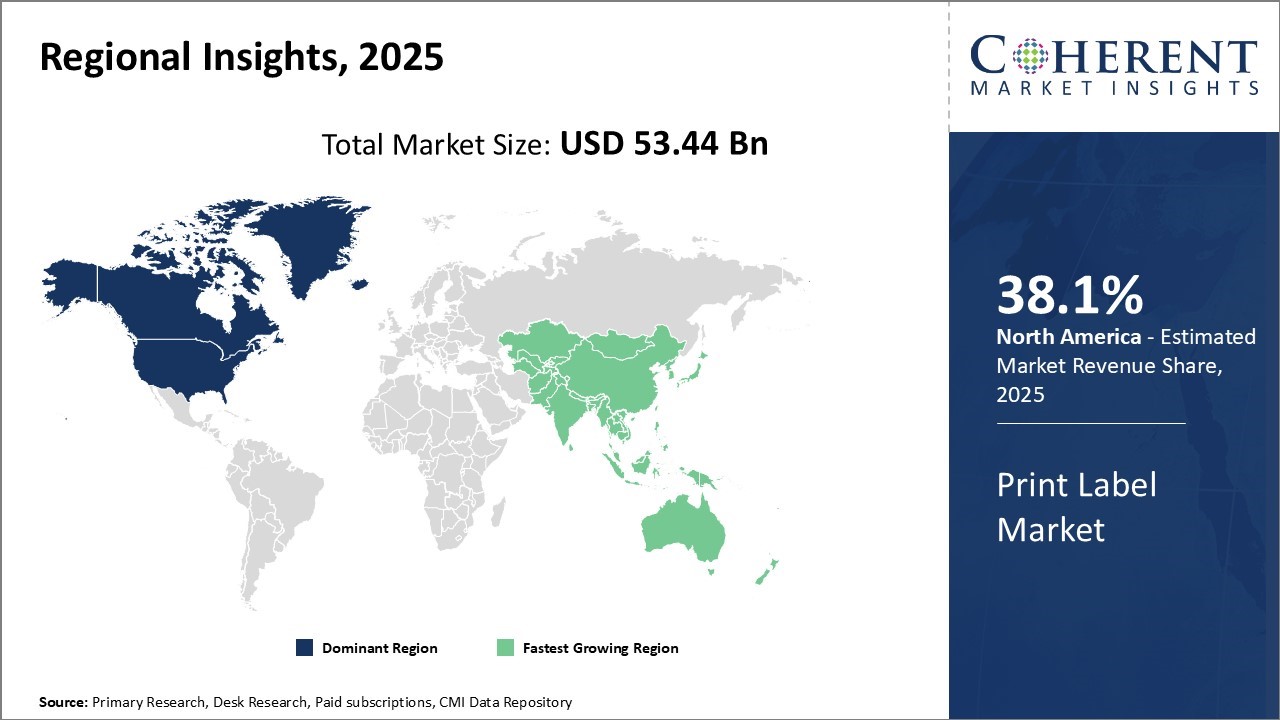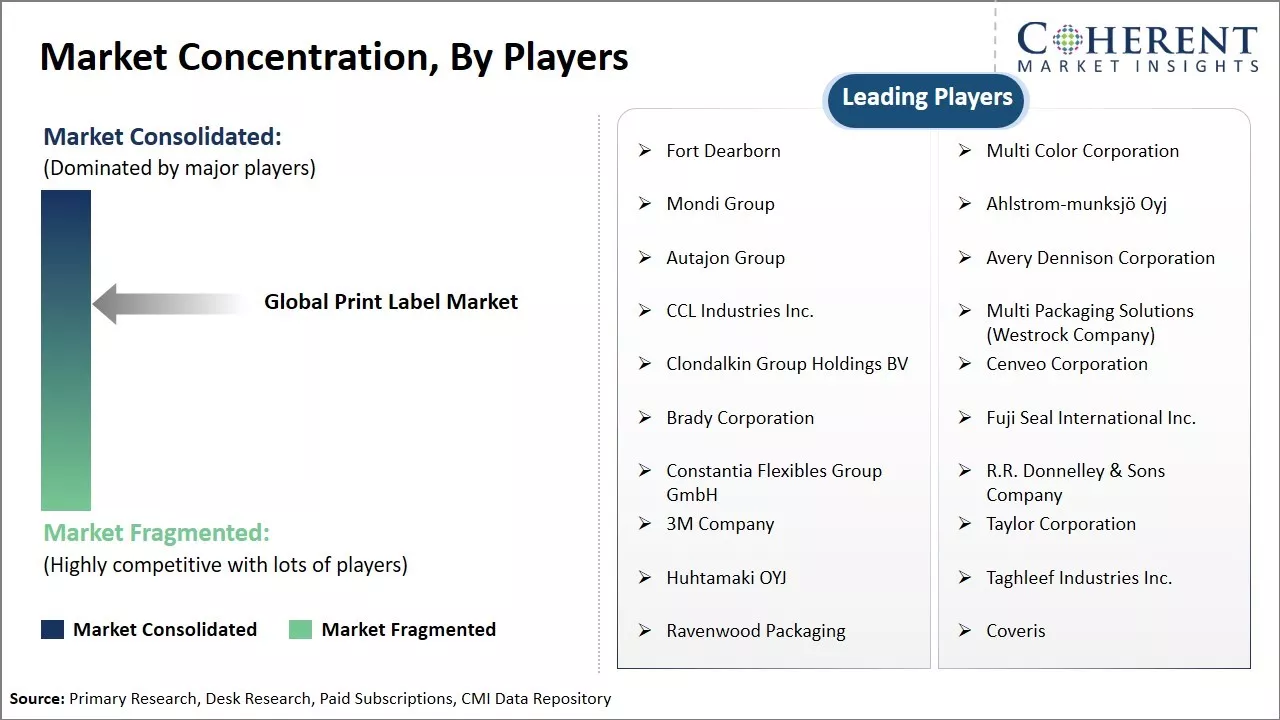The global print label market share is estimated to be valued at USD 53.44 Bn in 2025 and is expected to reach USD 72.77 Bn by 2032, growing at a compound annual growth rate (CAGR) of 4.5% from 2025 to 2032.

To learn more about this report, Download Free Sample
The growth of the print label market is primarily driven by increasing demand from the food & beverages industry. Traditional printing technology is being replaced by digital printing which offers benefits like variable data, on demand printing, and shorter turnaround time. Sustainable labeling is an emerging trend in the market with companies focusing on developing labels from recyclable and biodegradable materials to offer eco-friendly solutions. Innovation and development of smart labels integrated with QR codes, RFID, and NFC technology are anticipated to create new opportunities. These factors collectively highlight the rising print label market demand across multiple end-use industries.
|
Current Event |
Description and its Impact |
|
Technological Disruption |
|
|
Sustainability Pressures |
|
Uncover macros and micros vetted on 75+ parameters: Get instant access to report
The integration of artificial intelligence into print label in transforming the industry by optimizing design, production, customization and supply chain processes. AI-powered tools are enabling brands to generate personalized label designs at scale. For example, Coca-Cola’s “Share a Coke” campaign leveraged variable data printing, the area now enhanced by AI to create dynamic templates, color schemes, and typography tailored to individual preferences or demographics. AI systems monitor printing equipment to detect anomalies and predict breakdowns before they occur. This minimizes downtime and improves productivity in high-speed digital label presses from companies like HP Indigo and Xeikon. AI enables smart label integration with QR codes, NFC, and AR (Augmented Reality), providing consumers with interactive content, authenticity verification, and product traceability. These smart labels also feed data back to brands, which AI can analyze to refine marketing strategies.
In December 2024, Eurostampa unveiled a groundbreaking redesign of Nutella® labels using AI and digital printing. As part of its Envelope 8 project, in collaboration with Bria and HP, the initiative produced 9,000 distinct labels inspired by art movements like Cubism, Impressionism and Pop Art. Using HP Indigo presses, Eurostampa demonstrated scalable, high‑quality variable-data printing that combines artistic expression with industrial efficiency. The project marks a new era in personalized packaging innovation.
The print label market continues to evolve in response to shifting regulatory requirements, sustainability demands, and technological advancements. However, feedback from end-users highlights several recurring challenges and unmet needs that remain inadequately addressed across various industry segments.
Operational Complexity and Cost Inefficiency
A prevalent concern among end-users is the operational complexity associated with label creation and production workflows. Many reports frequent errors in label design and data entry due to outdated or non-intuitive user interfaces. These issues lead to reprints, material waste, and increased operational costs, particularly in high-throughput environments such as food and beverage, pharmaceuticals, and logistics.
Fragmented Data and Lack of System Integration
Another significant gap is the lack of seamless integration between labeling systems and enterprise data platforms such as ERPs and warehouse management systems. Many organizations still rely on manual data entry or disconnected processes, which increases the likelihood of labeling inconsistencies and compliance risks. The absence of centralized template control also contributes to errors and inefficiencies, especially in multi-site operations where consistency is critical.
Compliance and Traceability Challenges
Regulatory pressures continue to intensify, particularly regarding traceability, batch identification, and variable data requirements. Users in regulated industries have expressed the need for label printing solutions that can accommodate dynamic data inputs at high speed while maintaining strict compliance with GS1 standards, FDA regulations, and other local mandates. Current solutions often struggle to meet these demands without considerable customization or manual oversight.
User Experience and Technical Support Deficiencies
End-users frequently cite usability issues as a barrier to efficient label production. The lack of user-friendly design interfaces, coupled with limited training and support, hampers productivity and results in prolonged downtime. Additionally, off-the-shelf design platforms often fail to produce print-ready files, introducing further complications for print service providers.
In terms of label format, pressure-sensitive labels segment is expected to contribute 32.7% share of the market in 2025 owing to their convenient adhesive qualities. Unlike wet-glue labels which require activation with water or a printing solution, pressure labels can be applied directly without any additional adhesive activation step. This makes them significantly easier and faster to apply compared to other label types. The self-adhesive nature of pressure-sensitive labels streamlines labeling processes across many industries, reducing time and labor costs associated with application. Their adhesive properties also provide benefits in terms of labeling diverse surfaces. Pressure-sensitive labels can adhere effectively to irregular or curved surfaces without any special surface preparation needed. This flexibility expands possible applications beyond just flat or planar surfaces.
The adhesive technology allows pressure-sensitive labels to conform to any container or product shape. This conformability is valuable for labelers seeking to clearly mark complex or three-dimensional item designs. As automated labeling has increased in production environments, pressure-sensitive labels have seen growing use due to their compatibility with high-speed application equipment. Their self-adhesive characteristics mean they can be dispensed and precisely applied by labeling machinery without the need for additional activators like water or solvents. This compatibility with automation streamlines labeling processes for high-volume goods. It also reduces risks of misapplication compared to labels requiring a multi-step activation process.
In September 2024, UPM Raflatac became the first company to earn APR Design® for Recyclability Recognition for pressure‑sensitive labels on natural HDPE packaging. The certification, awarded by the Association of Plastic Recyclers, validates that its clear and white polypropylene labels—using hot‑melt, SmartCircle™ wash‑off, and general‑purpose acrylic adhesives meeting strict North American PET and HDPE recycling standards.
In terms of print process, offset segment is expected to contribute 36% share of the market in 2025 due to its ability to produce labels with high image quality and resolution. Offset printing delivers sharp, consistent, and vibrant colors, especially important for branding and packaging where visual appeal matters. It's preferred for labels on premium products like cosmetics, wine bottles, and luxury goods. While setup costs are higher, offset becomes more economical at scale. For long print runs, it's often cheaper per unit than digital printing, making it ideal for mass production in food, beverage, and household goods. Offset can print on a wide range of substrates, including paper, synthetic films, and textured label stock. This flexibility suits varied labeling needs from cartons to glass bottles. Offset allows Pantone color matching, metallic inks, embossing, and varnishes, offering greater control over detailed, premium finishes that elevate label appearance and durability. Offset presses are widely used and supported worldwide, ensuring easy access to skilled labor, spare parts, and service, making it a reliable choice for label converters.
In August 2024, Komori Corporation launched the Enthrone G29, its latest 29‑inch 4‑color offset printing press, enhancing efficiency, quality and eco‑performance in output. the G29 incorporates Smart Inking Flow technology from the Lithrone G advance series, dramatically reducing power consumption and improving return on investment.
In terms of end-user industry, food & beverages segment is expected to contribute 37.9% share of the global print label market in 2025 due to stringent regulatory requirements and consumer focus on product information. Packaging labels for food and drinks must clearly present nutrition information, ingredients list, allergen warnings, package characteristics like weight and volumes, and expiration dates to comply with various jurisdiction-level mandates. This extensive mandated labeling creates substantial demand for compliant print labels across global and domestic food and beverage brands. Beyond regulations, food and beverage manufacturers also utilize packaging labels to provide preparation instructions, storage and recycling guidelines, certifications like organic or fair-trade, responsible sourcing details, and ingredient sourcing transparency to address rising consumer interest in sustainable and ethical product attributes. Communicating such values and attributes on labels helps build brand trust and affinity among health-conscious buyers.
Labels also carry important safety information for perishable products. They help indicate freshness through expiration dates as well as guide proper handling through temperature control guidelines. This protects brand reputation by preventing illness from spoiled or mishandled products. As such, food and drinks rely heavily on packaging labels to both comply with regulations and assure consumer well-being, driving sustained demand for specialized print solutions in the industry.
In August 2024, Domino Printing Sciences launched its high‑speed Bottle Closure Printing Station, designed to support beverage manufacturers transitioning to label‑less PET bottles. The system prints variable data and machine‑readable codes including QR and GS1 codes on HDPE bottle caps, offering traceability and consumer engagement while simplifying recycling. In-line stations stabilize filled bottles and print at 300–900 dpi, achieving speeds up to 44,000 bottles per hour using Domino’s K300 monochrome printer, with pre‑ and post‑treatment plus integrated vision inspection.

To learn more about this report, Download Free Sample
North America has established itself as the dominant leader in the global print label market over the past few decades and is expected to account for 38.1% of the market share in 2025. The region is home to some of the largest label printing companies and converters in the world. It has a highly advanced labelling industry infrastructure with widespread availability of modern printing technologies such as digital printing. The North American market continues to thrive due to strong demand from various end-use industries such as food & beverage, chemicals, personal care & cosmetics, and pharmaceuticals. These industries rely heavily on labels for product identification, branding, and compliance with regulations.
Moreover, the presence of several multi-national FMCG and pharmaceutical companies in the region fuels continuous demand for large volumes of labels. Recently, American label company Avery Dennison announced its expansion in RFID-integrated smart labels for retail and logistics, underlining the region’s innovation leadership. Another key factor for North America's dominance is its proactive early adoption of new labelling technologies and materials. Regional players are at the forefront of developments in areas like shrink sleeve labels, functional QR coded, and RFID labels. This allows them to meet rapidly evolving customer requirements. The region also exports labels to major international markets, reinforcing its global footprint. These factors continue to power print label market growth across North America.
The Asia Pacific region has emerged as the fastest growing market for print labels in recent years. China and India are leading the growth and transforming into major manufacturing and exporting nations. Their expanding domestic markets lend strong impetus to label demand. The growing middle-class population with rising disposable incomes drives packaging consumption. Asia Pacific's development is supported by improving labelling infrastructure and increasing localization efforts of global brands. For example, in 2024, Multi-Color Corporation expanded its plant in Guangzhou to meet the rising demand for premium wine, spirits, and health product labels. Many international label players have set up manufacturing facilities to cater to the region. Additionally, the availability of economical labor and raw materials as well as lenient regulations have encouraged local label converters to rapidly modernize their facilities. This has enabled these regions to significantly reduce their past reliance on imports, further propelling the print label market revenue.
The U.S. print label market demand is being propelled by stringent regulations and the rising adoption of smart labeling technologies. The FDA’s updated Compliance Program now enforces strict requirements on nutrition labels, allergen declarations, and formatting, ensuring labels remain accurate and legible under all conditions, expanding the need for high-quality, durable printed labels. Meanwhile, smart labels featuring RFID and QR codes are gaining traction in the food and beverage sector. Companies like Avery Dennison are integrating RFID tags into packaging to track products across supply chains, anticipating full compliance with FDA food-traceability mandates by 2026. This shift toward digital labels ensures not only regulatory adherence but also enhances consumer trust, traceability, and inventory accuracy.
China’s print label market is experiencing a rapid industrialization and retail expansion across sectors like electronics, apparel, and FMCG. A key initiative in government policy is the rollout of digital QR-coded labels on over 40 food products, from dairy to meat, under a pilot led by the National Health Commission, enabling consumers to scan packages for detailed traceability information. Additionally, cities like Guangzhou have deployed blockchain- and RFID-based systems across 8,000 businesses to enhance oversight in agricultural and food markets. This alignment of consumer demand for transparency and state-led digitization is driving innovative, smart labeling solutions throughout China’s packaging ecosystem.

To learn more about this report, Download Free Sample
| Report Coverage | Details | ||
|---|---|---|---|
| Base Year: | 2024 | Market Size in 2025: | USD 53.44 Bn |
| Historical Data for: | 2020 To 2024 | Forecast Period: | 2025 To 2032 |
| Forecast Period 2025 to 2032 CAGR: | 4.5% | 2032 Value Projection: | USD 72.77 Bn |
| Geographies covered: |
|
||
| Segments covered: |
|
||
| Companies covered: |
Fort Dearborn, Multi Color Corporation, Mondi Group, Ahlstrom-munksjö Oyj, Autajon Group, Avery Dennison Corporation, CCL Industries Inc., Multi Packaging Solutions (Westrock Company), Clondalkin Group Holdings BV, Cenveo Corporation, Brady Corporation, Fuji Seal International Inc., Constantia Flexibles Group GmbH, R.R. Donnelley & Sons Company, 3M Company, Taylor Corporation, Huhtamaki OYJ, Taghleef Industries Inc., Ravenwood Packaging, and Coveris |
||
| Growth Drivers: |
|
||
| Restraints & Challenges: |
|
||
Uncover macros and micros vetted on 75+ parameters: Get instant access to report
One of the primary drivers fueling growth in the global print label market is the increasing preference for flexible packaging among brand owners and consumers alike. Flexible packaging offers several advantages over rigid packaging formats such as ease of use, ability to fit varied product sizes and shapes, and potential for multi-purpose functionality through re-sealability or reclosability. It allows brand owners to appeal to busy, urbanized consumers seeking convenient packaging designs that are easy to handle, store, and reuse or recycle.
Moreover, the lightweight and compact nature of flexible packaging helps reduce transportation and logistics costs. Various players in the F&B, pharmaceuticals, personal care, and home care sectors have shifted significant volumes of their product portfolios to flexible packaging in the form of stand-up pouches, bags, sleeves, and wraps. As flexible packaging continues to gain prominence, print label manufacturers are witnessing growing demand for customized adhesive labels, shrink sleeves, wraparound labels, and other variants suitable for flexible substrates.
Another key trend steering market expansion is the preference among brand owners as well as consumers for sustainable and environment-friendly labelling solutions. Building on the widespread focus on reducing plastic waste and carbon footprint of packaging, companies manufacturing print labels have been innovating new varieties of labels made from recycled, bio-based, and compostable materials. Novel labelling technologies are also being adopted for producing labels without harmful chemicals and enabling full recyclability. The introduction of labelling films made from renewable feedstock and enabled with advanced recycling has been well-received. Driven by rising eco-awareness and preference for brands that demonstrate sustainable practices, the demand for such labels integrating green attributes is expected to surge significantly across regions in the coming years. This will open up attractive growth prospects for print label manufacturers oriented toward developing and scaling up sustainable labels.
*Definition: The global print label market consists of companies involved in the production and sales of various types of printed labels that are used extensively across many industries for product identification, branding, and packaging purposes. Key players in this market manufacture labels using different materials like paper, plastic, and metal through various printing technologies such as flexography, lithography, and digital printing. They provide labels to end-use industries worldwide including food & beverages, consumer durables, personal care, pharmaceuticals, and retailing.
Share
Share
About Author
Shivam Bhutani has 6 years of experience in market research and strategy consulting. He is a Market Research Consultant with strong analytical background. He is currently an MBA candidate specializing in Business Analytics from BITS Pilani.
He is adept at navigating diverse roles from sales and marketing to research and strategy consulting. He excels in market estimation, competitive intelligence, pricing strategy, and primary research. He is skilled at analysing large datasets to provide precise insights, helping clients in achieving strategic transformation across various industries. He is skilled in leveraging data visualization techniques to drive innovation and enhance business processes.
Missing comfort of reading report in your local language? Find your preferred language :
Transform your Strategy with Exclusive Trending Reports :
Frequently Asked Questions
Joining thousands of companies around the world committed to making the Excellent Business Solutions.
View All Our Clients